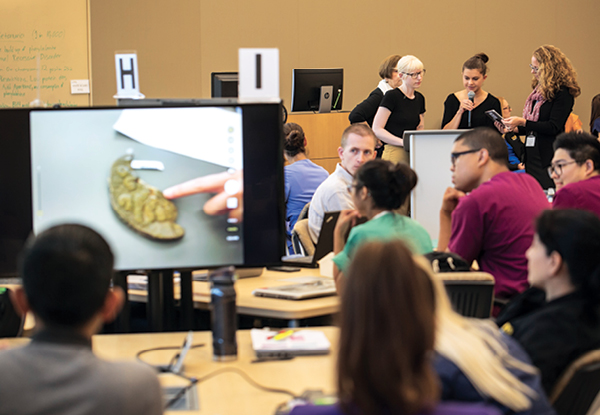
Active learning leverages technological innovation, fosters student engagement
The hum of the air conditioning. The dimly lit room. The monotonous voice of a professor orating from a podium. These paint the picture of university lecture halls around the world and the cornerstone of how course instruction was experienced in higher education for decades.
The buzz of conversation. The palpable energy across the table. A passionate educator brings clinical concepts to life. This is the new reality in the active learning classrooms at the Betty Irene Moore School of Nursing at UC Davis.
Education across the board continues to undergo a paradigm shift from the classic traditional lecture model to one that is student and active-learning centered with problem-based approaches to learning.
“The memorization model may work fine for many early undergraduate courses, but our graduate students need to look at applying their knowledge to real-world problems with patients who are complex,” says Cara Sandholdt, an assistant adjunct professor teaching anatomy, physiology and pathophysiology for the family nurse practitioner and physician assistant programs.
“Things are not black and white in health care. Our students need to critically think and apply. We want them to thrive even in the gray areas,” she says.
To foster those critical thinking skills, leaders at the School of Nursing designed active learning spaces in the new School of Nursing home, Betty Irene Moore Hall. The propeller table configuration breaks up large classroom sizes naturally to create team-based learning. The technology enables faculty to present to the entire class while walking around the room or individual groups to take over the monitors at their tables to collaborate.
“Health education has long featured problem-based learning in simulation spaces with mannequins. These classrooms now extend that focus to the didactic portion of their education,” explains Elizabeth Rice, associate dean for clinical education and practice.
Faculty create experiences in which students receive fact-based, textual information outside of the classroom, such as readings, real-time lectures, even pop quizzes, via a cloud-based learning management system. Classroom time is then devoted to making students
think about how to apply that information to real-world problems and actively think through what they do and do not understand. The addition of an interactive whiteboard for tablets, and a live interactive participation tool further engage students and make better use of the space.
“As faculty, we must move from professor to facilitator and partner with our students on this journey,” Sandholdt adds. “They arrive with so much knowledge and have so much to offer that this partnership can become rich when we support their engagement and ask them to play a more active role in their learning.”
School of Nursing leaders envision a not-so-distant future when students will experience interactive virtual patient experiences, so they can simulate doing an exam on a patient online, then come to class and discuss the encounter. Such simulations would feature the same patients students already assess across their quarters of study in the school’s integrative case-based learning curriculum.
“We know we are on the cutting edge and what we’re doing is hard for both students and faculty. We know to be successful we must decide on a course and stick to it,” Rice explains. “We believe that by doing the heavy lifting now, not only will it improve the experiences and outcomes of our students, but it will produce valuable resources for the entire nursing and health care education community.”

